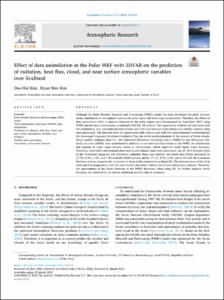| dc.contributor.author | Kim, Dae-Hui | |
| dc.contributor.author | Kim, Hyun Mee | |
| dc.coverage.spatial | Arctic Region | en_US |
| dc.date.accessioned | 2023-05-14T19:23:48Z | |
| dc.date.available | 2023-05-14T19:23:48Z | |
| dc.date.issued | 2022 | |
| dc.identifier.citation | Kim, D.-H. and Kim, H. M. (2022) Effect of data assimilation in the Polar WRF with 3DVAR on the prediction of radiation, heat flux, cloud, and near surface atmospheric variables over Svalbard. Atmospheric Research, 272: 106155. 18pp. DOI: https://doi.org/10.1016/j.atmosres.2022.106155 | en_US |
| dc.identifier.uri | https://repository.oceanbestpractices.org/handle/11329/2216 | |
| dc.description.abstract | Although the Polar Weather Research and Forecasting (PWRF) model has been developed for polar environments, simulations of atmospheric states in the polar region still have large uncertainties. Therefore, the effects of data assimilation (DA) to improve forecasts in the polar region were investigated for September 2017 using PWRF and the three-dimensional variational (3DVAR) DA method. The experiments without DA and those with DA assimilating only conventional observations and both conventional observations and satellite radiance data were performed. The forecasts from all experiments both without and with DA underestimated (overestimated) the downward longwave (shortwave) radiation flux due to the underestimation of the amount of Arctic clouds. When satellite radiance data (i.e., the Advanced Microwave Sounding Unit-A (AMSU-A) and Microwave Humidity Sounder (MHS)) were assimilated in addition to conventional observations in the PWRF, the distribution and amount of water vapor became closer to observations, which improves cloud liquid water forecasts. Therefore, when both conventional observations and radiance data were assimilated, the 25-30 h forecast errors of the downward longwave and shortwave radiation fluxes and sensible and latent heat fluxes decreased by 12.7%, 8.1%, 3.2%, and 7.8% with the WSM5 scheme and by 17.1%, 4.7%, 2.5%, and 3.1% with the 2-moment Morrison scheme, respectively, compared to those in the experiments without DA. The forecast errors of the 10 m wind and 2 m temperature with DA were smaller than those without DA at most observation stations. Therefore, the uncertainties of the Arctic forecasts in the PWRF decreased when using DA. To further improve Arctic forecasts, the assimilation of various additional satellite data is necessary. | en_US |
| dc.language.iso | en | en_US |
| dc.rights | Attribution 4.0 International | * |
| dc.rights.uri | http://creativecommons.org/licenses/by/4.0/ | * |
| dc.subject.other | Polar weather forecasting | en_US |
| dc.subject.other | Uncertainty | en_US |
| dc.subject.other | Satellite data assimilation | en_US |
| dc.title | Effect of data assimilation in the Polar WRF with 3DVAR on the prediction of radiation, heat flux, cloud, and near surface atmospheric variables over Svalbard. | en_US |
| dc.type | Journal Contribution | en_US |
| dc.description.refereed | Refereed | en_US |
| dc.format.pagerange | 18pp. | en_US |
| dc.identifier.doi | http://dx.doi.org/10.1016/j.atmosres.2022.106155 | |
| dc.subject.parameterDiscipline | Atmosphere | en_US |
| dc.subject.dmProcesses | Data analysis | en_US |
| dc.subject.dmProcesses | Data visualization | en_US |
| dc.bibliographicCitation.title | Atmospheric Research | en_US |
| dc.bibliographicCitation.volume | 272 | en_US |
| dc.bibliographicCitation.issue | 106155 | en_US |
| dc.description.sdg | 14.a | en_US |
| dc.description.maturitylevel | Mature | en_US |
| dc.description.methodologyType | Reports with methodological relevance | en_US |
| obps.contact.contactname | Hyun Mee Kim | |
| obps.contact.contactemail | khm@yonsei.ac.kr | |
| obps.resourceurl.publisher | https://www.sciencedirect.com/science/article/pii/S0169809522001417?via%3Dihub | |
 Repository of community practices in Ocean Research, Applications and Data/Information Management
Repository of community practices in Ocean Research, Applications and Data/Information Management

